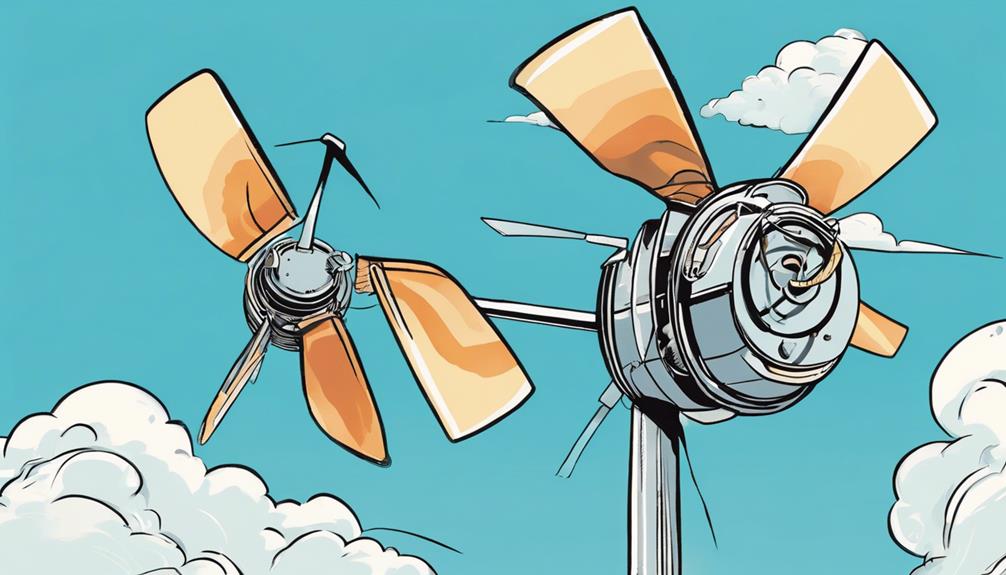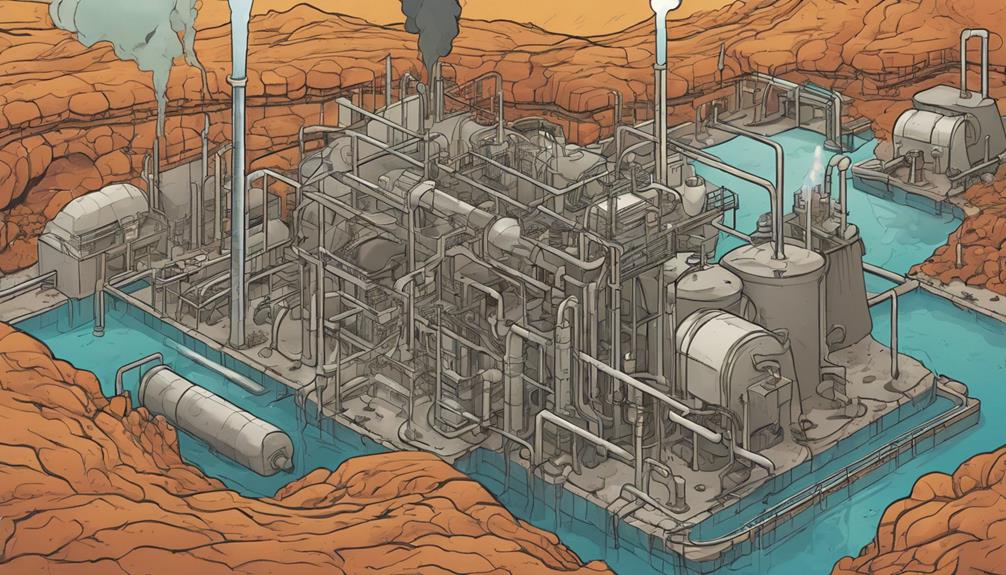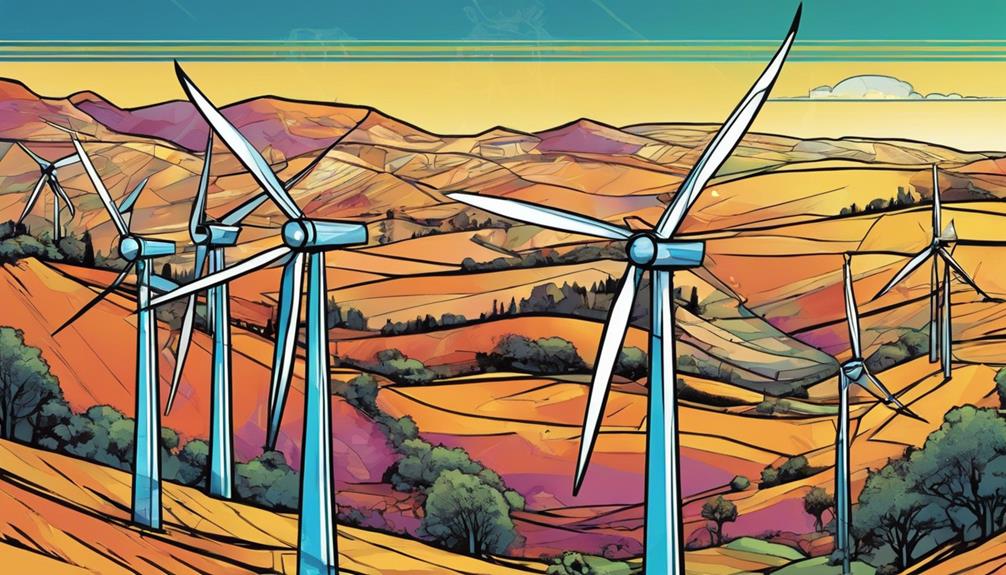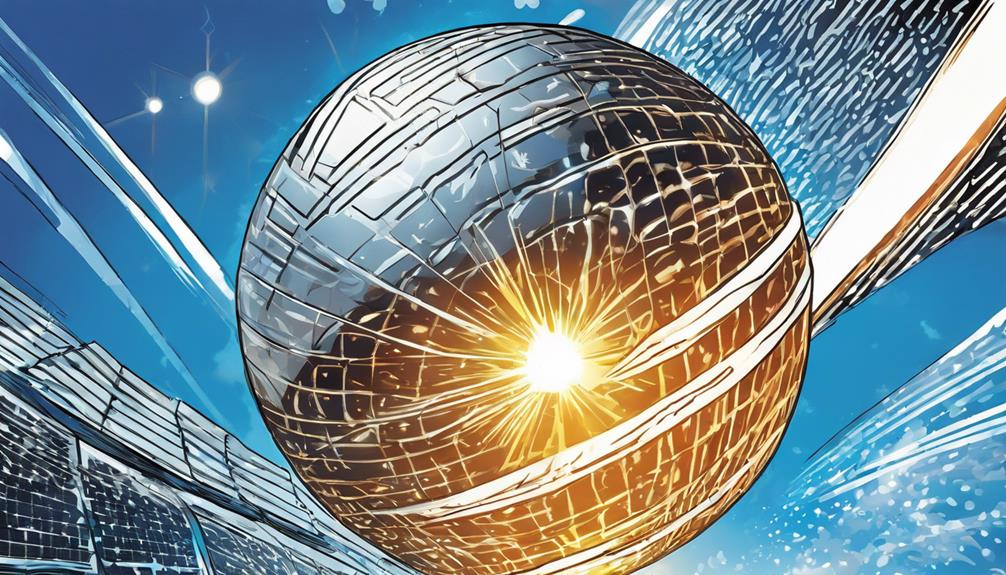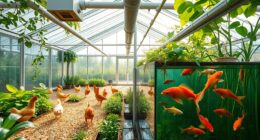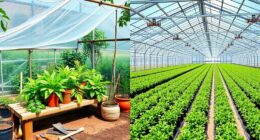You're wondering who collects solar energy for plant cells? It's chloroplasts, specialized organelles that capture sunlight energy for photosynthesis. These tiny powerhouses have a double membrane structure housing thylakoid membranes containing light-harvesting complexes and electron transport chains. Chlorophyll molecules in these complexes absorb red and blue light wavelengths, exciting electrons that generate ATP and NADPH. This energy is stored as glucose, fueling plant growth. As you explore further, you'll uncover the intricate processes that make this energy conversion possible, and just how essential chloroplasts are to plant survival. Factors affecting solar energy loss include environmental conditions such as temperature, light intensity, and water availability. Too much heat can damage the thylakoid membranes, impacting their ability to capture sunlight energy. Likewise, insufficient light or water can hinder the photosynthesis process, leading to decreased energy production. Understanding these factors is crucial in optimizing plant growth and ensuring efficient solar energy utilization within chloroplasts.
Key Takeaways
- Chloroplasts, specialized organelles in plant cells, collect solar energy for photosynthesis, converting it into chemical energy.
- Thylakoid membranes within chloroplasts absorb sunlight, generating a proton gradient for glucose production.
- Chlorophyll molecules, embedded in thylakoid membranes, absorb red and blue light wavelengths, driving ATP and NADPH production.
- Light-harvesting complexes, containing chlorophyll pigments, capture red and blue light for glucose production, essential for plant growth.
- Chloroplasts harness sunlight, producing ATP and NADPH, which are stored as glucose, fueling plant growth and metabolism.
Chloroplast Structure and Function
Delving into the inner workings of plant cells, you'll find chloroplasts, specialized organelles that capture sunlight energy for photosynthesis through their unique structure and function.
As an organelle found in plant cells, chloroplasts play a pivotal role in converting solar energy into a usable form. Their double membrane structure houses the necessary components for energy conversion, including thylakoid membranes with light-harvesting complexes and electron transport chains. These complexes work together to harness light energy, which is then used to power the photosynthetic process.
Through this process, chloroplasts are involved in photosynthesis, producing glucose for plant growth and development. Essentially, chloroplasts are the site of photosynthesis, where energy from sunlight is absorbed and converted into a form that's usable by the plant.
The Role of Chlorophyll in Photosynthesis

As you explore the role of chlorophyll in photosynthesis, you'll discover how its unique absorption spectrum enables it to capture sunlight energy.
You'll learn how this energy is converted into a usable form through a complex process.
Now, let's examine the specifics of chlorophyll's absorption spectrum, energy conversion, and its role in light-harvesting complexes.
Chlorophyll's Absorption Spectrum
When you examine the absorption spectrum of chlorophyll, you'll notice it has a unique ability to absorb red and blue light wavelengths, which is vital for ideal photosynthesis in plant cells. This specific absorption pattern allows chlorophyll to capture the energy from sunlight that's necessary to power photosynthesis.
You might wonder why leaves appear green; it's because chlorophyll reflects green light while absorbing other wavelengths.
The visible light spectrum is where chlorophyll's absorption peaks are found. Different types of chlorophyll molecules have varying absorption peaks within this spectrum, but they all play an important role in capturing energy for photosynthesis.
The unique structure of chlorophyll molecules is responsible for their ability to capture specific wavelengths of light. This energy is then used to fuel the process of photosynthesis in chloroplasts, where chlorophyll is present.
Energy Conversion Process
You're about to uncover the detailed process by which chlorophyll converts sunlight energy into chemical energy, an essential step in powering photosynthesis in plant cells.
As you've learned, chlorophyll's unique absorption spectrum allows it to capture sunlight energy. But what happens next? When chlorophyll molecules absorb light energy, they become excited, triggering an energy conversion process.
This process takes place within thylakoid membranes, where chlorophyll molecules are embedded. Here, the energy from light is used to generate ATP and NADPH, two energy-rich molecules crucial for photosynthesis.
Chlorophyll plays a vital role in converting solar energy into chemical energy, which is then stored as glucose. This energy conversion process is the backbone of photosynthesis, allowing plant cells to produce the energy they need to grow and thrive.
Without chlorophyll, photosynthesis wouldn't be possible, and life on Earth would be vastly different. As you explore further into the world of plant cells, you'll discover just how essential this energy conversion process is.
Light-Harvesting Complexes
Within the thylakoid membranes of chloroplasts, light-harvesting complexes containing chlorophyll molecules capture sunlight energy, setting the stage for the conversion of solar energy into chemical energy.
You might wonder how these complexes work their magic. It's quite fascinating! Chlorophyll pigments within these complexes absorb red and blue light wavelengths, which are then used to fuel photosynthesis. This energy is essential for the production of glucose, the energy-rich molecule that powers plant growth.
As you explore the role of light-harvesting complexes, you'll discover that they're embedded in thylakoid membranes within chloroplasts. This strategic placement allows them to maximize their energy-absorbing potential.
The absorbed light energy is then converted into chemical energy, which is used to produce glucose. Essentially, light-harvesting complexes play a critical role in the initial stages of photosynthesis, capturing solar energy and setting the stage for the energy conversion process.
Energy Conversion in Chloroplasts

As you explore the inner workings of chloroplasts, you'll discover how they expertly convert sunlight into usable energy for plant cells.
You're about to learn how chloroplasts capture and convert light energy into a form that fuels plant growth and metabolism.
Let's examine the energy capture process, light energy conversion, and how solar power is harnessed within these tiny organelles.
Energy Capture Process
Chloroplasts kick-start the energy capture process by harnessing sunlight, which is then converted into chemical energy through a complex series of reactions. You might wonder how they do it. Well, it's quite fascinating! Chlorophyll, a pigment within chloroplasts, absorbs sunlight for photosynthesis. This energy is then converted into glucose molecules, which are essential for plant growth and metabolism.
Here's a breakdown of the energy capture process in chloroplasts:
| Step | Description |
|---|---|
| 1 | Chlorophyll absorbs sunlight |
| 2 | Energy is converted into ATP and NADPH |
| 3 | ATP and NADPH are used to convert CO2 into glucose |
| 4 | Glucose is produced and stored in plant cells |
| 5 | Energy is released for plant growth and metabolism |
Through this intricate process, chloroplasts collect solar energy and convert it into a usable form for plants. This energy capture process is essential for plant development and survival. Without it, plants wouldn't be able to grow, thrive, or respond to their environment.
Light Energy Conversion
Frequently, you'll find that the thylakoid membranes within plant cells are the sites where light energy is converted into chemical energy through a complex process. This process, known as photosynthesis, takes place in chloroplasts, organelles found in plant cells responsible for collecting solar energy.
Within these chloroplasts, photosystems I and II play essential roles in converting light energy into usable forms like ATP and NADPH.
Chlorophyll, a pigment present in chloroplasts, absorbs specific wavelengths of light, facilitating the energy conversion process. As light energy is captured, it's used to drive the production of ATP and NADPH.
These energy-rich molecules are then utilized to power the conversion of carbon dioxide and water into glucose, the primary source of energy for plant cells.
In essence, the light energy conversion process in chloroplasts is a pivotal step in photosynthesis. It's here that the energy from sunlight is harnessed and transformed into a usable form, allowing plants to grow, thrive, and sustain life.
Solar Power Harnessed
Within the chloroplasts, you're harnessing the power of solar energy, which is then converted into chemical energy through a complex process. This energy conversion is important for photosynthesis, allowing plants to grow and thrive.
Here's how it works:
- Thylakoid membranes facilitate energy conversion, absorbing sunlight and generating a proton gradient that drives ATP production.
- Chlorophyll, a green pigment in chloroplasts, captures sunlight, exciting electrons that are then used to produce glucose.
- Solar energy is converted into chemical energy, which is stored in glucose molecules, providing energy for plant growth and development.
In essence, chloroplasts are the site of solar power harnessing, where solar energy is converted into a usable form for plants. This intricate process is vital for plant survival, and it's all thanks to the chloroplasts' remarkable ability to capture and convert solar energy.
Plant Cell Wall Composition and Function

As you explore the intricate world of plant cells, you'll discover that their walls are composed of a unique blend of cellulose, hemicellulose, pectin, lignin, and soluble proteins, all working together to provide structure and support. This complex composition serves an essential function, giving plant cells the strength and protection they need to thrive.
The cell wall's primary function is to provide tensile strength, maintaining the cell's structural integrity and regulating turgor pressure, which contributes to the cell's shape and rigidity.
The plant cell wall is composed of multiple layers, each with its own unique function. The primary, middle lamella, and secondary layers work together to support plant growth, development, and defense against environmental stressors.
The cell wall's composition and function are crucial for plant cells to adapt to their environment and respond to external stimuli. By understanding the intricate details of plant cell walls, you'll gain a deeper appreciation for the intricate mechanisms that allow plants to harness solar energy and thrive in their ecosystems.
Vacuoles and Cell Size Regulation

You've explored the complex composition and function of plant cell walls, but now let's shift our focus to the dynamic organelles that help regulate cell size: vacuoles. These membrane-bound structures play an essential role in maintaining the size and shape of plant cells. By controlling the amount of water and solutes, vacuoles regulate cell size and turgor pressure, providing structural support and rigidity to the cell.
Here are some key ways vacuoles influence cell size regulation:
- Vacuoles store water and solutes: By controlling the amount of water and solutes, vacuoles help maintain the cell's turgor pressure, which is vital for plant growth and development.
- Vacuoles contribute to cell volume: As vacuoles store nutrients, ions, and waste products, they contribute to the overall volume of the plant cell, influencing its shape and function.
- Vacuoles exchange nutrients with other organelles: Through fusion with other organelles, vacuoles facilitate the exchange of nutrients and waste products, maintaining cellular homeostasis.
Origins of Chloroplasts and Photosynthesis

Chloroplasts, the tiny powerhouses responsible for capturing light energy, owe their existence to an ancient symbiotic event that brought photosynthetic prokaryotes into the fold of early eukaryotic cells. You're likely wondering what this means.
Fundamentally, chloroplasts originated from an ancient partnership between early cells and photosynthetic bacteria. Over time, these bacteria evolved into organelles that could harness light energy for their hosts.
As you explore the structure and function of chloroplasts, you'll notice their striking resemblance to ancient cyanobacteria. It's no coincidence, given their shared ancestry. The evolution of photosynthesis dates back to the early development of cells on Earth, and chloroplasts have retained many characteristics from their cyanobacterial ancestors.
For instance, they've small circular genomes similar to those found in cyanobacteria. Most chloroplast proteins, however, are now encoded by the nuclear genome of plant cells.
This ancient symbiotic event paved the way for the development of complex life on Earth, and you're now one step closer to understanding the fascinating story of how chloroplasts came to be.
Frequently Asked Questions
What Absorbs Solar Power for the Plant Cell?
You're wondering what absorbs solar power for the plant cell? Well, it's chlorophyll, a pigment in chloroplasts, that absorbs sunlight and converts it into chemical energy, driving photosynthesis and growth!
What Is Responsible for Capturing Solar Energy in Plants?
You think it's a superhero, but surprisingly, it's not a cape-wearing plant saver – it's actually the humble chloroplasts, tiny organelles inside plant cells, that are responsible for capturing solar energy, and they do it with ease!
What Organelle Collects Solar Energy?
You're wondering what organelle collects solar energy? Well, it's the chloroplasts that do the job, converting sunlight into chemical energy through photosynthesis, producing glucose for plant cells, and they're pretty good at it!
What Collects Solar Energy?
"Hey, you're wondering what collects solar energy? Well, it's not your new solar-powered smartwatch (although that's cool too!). It's actually chlorophyll, the superhero pigment in chloroplasts, that absorbs sunlight to fuel plant growth – no battery recharge needed!"
Conclusion
You've now explored the fascinating world of plant cells, where chloroplasts collect solar energy to power photosynthesis.
But here's a stat that'll leave you amazed: did you know that if you were to combine all the chlorophyll on Earth, it would weigh around 10 billion kilograms? That's a lot of green power!
It's a proof of the incredible importance of chloroplasts in sustaining life on our planet.



